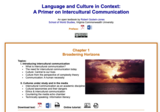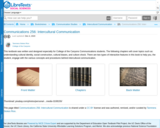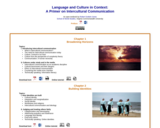
Sample syllabus to accomany open textbook on intercultural communication
- Subject:
- World Cultures
- Material Type:
- Syllabus
- Author:
- Robert Godwin-Jones
- Date Added:
- 02/15/2022

Sample syllabus to accomany open textbook on intercultural communication

This textbook was written and designed especially for College of the Canyons Communications students. The following chapters will cover topics such as: understanding cultural identity, social construction, cultural biases, and culture shock. There are two types of interactive features in this book to help you, the student, engage with the various concepts and procedures behind intercultural communication.

In the quest to explore the multiple facets of intercultural communication, this book is divided into three general areas: foundations, elements, and contexts. The foundations cover the basic principles associated with communication studies and culture. The elements move beyond the basics into self, identities, verbal, and nonverbal process associated with communication and culture. Contexts explore all the different environments such as media, business, and education, in which intercultural communication occurs.

If all cultures developed the ability to communicate, why do we see things so very differently? What purpose did communication serve in a culture? How did some cultures develop ways in which to share and negotiate meaning that my culture did not? Can I truly communicate with someone that doesn’t share my dominant culture? What does competent intercultural communication “look” like? In the quest to explore the multiple facets of intercultural communication, this book is divided into three general areas: foundations, elements, and contexts. The foundations cover the basic principles associated with communication studies and culture. The elements move beyond the basics into self, identities, verbal, and nonverbal process associated with communication and culture. Contexts explore all the different environments such as media, business, and education, in which intercultural communication occurs.

This open textbook is designed to serve as an introductory textbook for undergraduate courses in intercultural communication. The chapters incorporate ideas from intercultural communication broadly conceived and draw on approaches from the many different academic disciplines that have contributed to the field. There is an effort throughout to incorporate approaches and views on intercultural communication from a geographically diverse array of scholars, supplementing the author's own North American perspective.